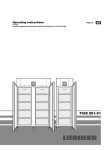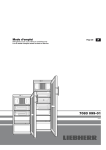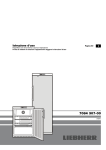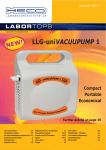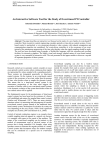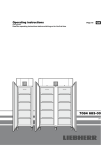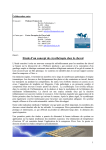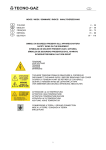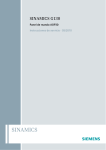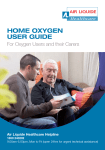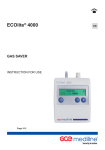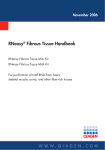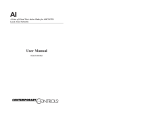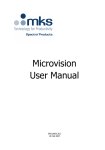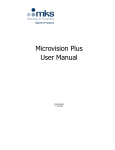Download Laboratory technical sales manual
Transcript
Laboratory technical sales manual Contents LKPv and LGPv laboratory appliances with Profi-Controller Alarm, memory and safety functions Temperature, door-open and power failure alarms Internal system alarms Internal memory functions Special safety functions Temperature and alarm documentation External temperature and alarm monitoring connections External alarm contact connection Product temperature monitoring connection Safety feature table Temperature consistency and distribution according to NF X 15 -14 Description of the NF X 15-140 test procedure Results according to NF X 15-140 LK(U)v, LCv, LK(U)exv, LG(U)ex and LGT laboratory appliances with Comfort-Controller Alarm, memory and safety functions Temperature, door-open and power failure alarms Internal system alarm Internal memory functions Special safety function Temperature and alarm documentation External temperature and alarm monitoring connection External alarm contact connection Product temperature monitoring connection Safety feature table Temperature consistency and distribution according to NF X 15 -140 Description of the NF X 15-140 test procedure Results according to NF X 15-140 Loading plan: low temperature chest freezers with kryo racks Pharmacy refrigerators compliant to DIN 58345 2 LKPv and LGPv laboratory appliances with Profi-Controller blokke Duits, Tempe keurig Alarm, memory and safety functions Liebherr Mediline refrigerators and freezers with Profi-Controller help to protect your inventory. These cabinets offer a variety of alarm, memory and safety features designed to greatly reduce the risk of loss of contents. Doorv Temperature, door-open and power failure alarms High and low temperature alarms All LKPv and LGPv modells have integrated high and low internal air temperature alarms with both audio and visual signals. The factory settings for the alarm limits are + 3 /– 2 K in relation to the set temperature. If the set temperature is altered to meet a specific storage temperature requirement then the alarm settings move in parallel and do not need to be adjusted separately. There is a 30 minute delay to avoid unwanted alarms due to e.g. door opening. Boveni openin die d externe andere voeren Door-open alarm All LKPv and LGPv modells register when doors are left open or ajar and have an integrated audio and visual door-open alarm. This alarm has a 1 minute delay which can be adjusted. Bevei Power failure alarm All LKPv and LGPv modells have a battery back-up which operates an audio and visual alarm immediately upon power failure. Both the integrated temperature data logger and the optional external temperature monitoring via the RS 485 interface continue to function during power failure for up to 72 hrs. Internal system alarms Een 1 verlore wordt geregis beschi gegeve The following alarms are related to internal self-checks of the refrigeration system and the electronic controller probes. While these might not be immediately relevant to the everyday operation of the cabinets they do provide added security by warning probably before the air temperature probe registers an alarm condition. They also provide a service engineer with valuable information thus allowing quicker intervention. High condenser temperature alarm This integrated audio and visual alarm warns of excessive condenser temperatures possibly caused by e.g. high ambient temperatures or blocked air-flow to or from the refrigeration system. Low evaporator temperature alarm This integrated audio and visual alarm warns of low evaporator temperatures possibly caused by e.g. defective air-circulation fan or blocked internal air-flow. This alarm will possibly warn much sooner than the high or low temperature alarm. Probe failure alarm As a self-control system, defective probes are registered and the controller cause an audio and visual alarm signal. In case of an air-probe error the controller has pre-defined operating modes to maintain the internal temperature at + 5 °C. Eenvo De mo boveni Voor r is de v zwenk van 45 3 Maxim LKPv and LGPv laboratory appliances with Profi-Controller Internal memory functions Internal alarm memory This function stores to memory details of the last 30 alarms: time and date of the start and the end of the alarm condition, the type of the alarm condition and the maximum and minimum internal air temperatures measured during this alarm condition period are registered. Internal temperature memory This function stores to the memory the internal temperature profile at 4-minute intervals. 2800 temperature logs are stored to memory, which corresponds to approximately a 7-day logging period. 40 °C 30 °C 20 °C 10 °C 0 °C -10 °C -20 °C 17.07.2009 18.07.2009 19.07.2009 -30 °C 16.07.2009 12:00 18:00 00:00 06:00 12:00 18:00 00:00 06:00 12:00 18:00 00:00 06:00 12:00 18:00 Special safety functions Solid-state relay for maximum reliability The LKPv and LGPv models all have a solid-state relay guaranteed to > 1 billion compressor start cycles. As well as allowing very accurate temperature control this feature practically excludes the possibility of burnt relay contacts as a cause for extreme internal temperatures. Double fan cooling All LKPv and LGPv modells have a double internal fan arrangement so that in case of one defective fan the cooling system continues to function at reduced capacity. The highly reliable fans Liebherr uses are guaranteed to 80 000 hrs operating time. 4 LKPv and LGPv laboratory appliances with Profi-Controller Temperature and alarm documentation Liebherr Mediline refrigerators and freezers with Profi-Controller help to protect your inventory. These cabinets offer a variety of features and options designed both for external monitoring of the internal temperatures, the product temperatures and alarm conditions to greatly reduce the risk of loss of contents. External temperature and alarm monitoring connections Infrared interface and optional infrared key All LKPv and LGPv models have an integrated temperature data logger which stores up to 2800 air-probe temperature values recorded at 4 minute intervals, which equals approximately 7.7 days. In order to use this data an infrared device (“key”) is available as an optional extra. The data is transferred from the infrared interface on the cabinet to the “infrared key”. This “key” is then connected by cable to a PC or laptop and the data is transferred onto the dedicated software on the PC. Only one set of data i.e. from one cabinet, can be transferred at one time. The optional kit includes all the necessary components: key, cable and software including manual. The software allows visualisation and analysis of the temperature data in various formats including a graph. The data can also be exported to Excel, Word and other standard formats for storage or further analysis. Liebherr Temperature Monitoring Software for Serial Interface & Infrared key Deutsch English Français Italiano Español Example: visualisation of temperature data Internal temperature 40 °C 36 °C 32 °C 28 °C 24 °C 20 °C 16 °C 12 °C 8 °C 4 °C 0 °C – 4 °C – 8 °C – 12 °C – 16 °C – 20 °C – 24 °C – 28 °C 16.07.2009 12:00 16.07.2009 18:00 17.07.2009 00:00 17.07.2009 06:00 17.07.2009 12:00 17.07.2009 18:00 18.07.2009 00:00 18.07.2009 06:00 18.07.2009 12:00 18.07.2009 18:00 19.07.2009 00:00 19.07.2009 06:00 19.07.2009 12:00 19.07.2009 18:00 5 LKPv and LGPv laboratory appliances with Profi-Controller RS 485 interface and optional signal converter All LKPv and LGPv models have an RS 485 interface. If an RS 485 monitoring system is not already in place, a converter kit is available as an optional extra to convert the RS 485 signal to an RS 232 signal and allow connection to a PC or laptop. The RS 485 bus connection is made using standard shielded data cables, e.g. type LiYCY 2 x 0,14 mm2. The maximum possible length of the data lines depends on the quality of the components used. The maximum range is 500 m. A maximum of 20 appliances can be wired in series. BUS line appliance 1 appliance 2 appliance 20 Dedicated software is provided in the accessory package allowing visualisation, analysis and export to other formats for storage. The software reads the air-probe temperature at 2 minute intervals and records alarm conditions. When an alarm condition is registered the software will warn on the PC on which the software is running. If this PC is not supervised (e.g. at night or over weekends) then the alarm signal might not be recognised. In order to avoid unrecognised alarms the software includes an email function, which sends an email in case of an alarm condition to predefined email addresses. These emails can be easiliy checked with a smartphone. Therefore the user will be warned without having direct access to a computer. Liebherr Temperature Monitoring Software for Serial Interface & Infrared key Deutsch English Français Italiano Español Networking Both laboratory appliances with Profi-Controller as well as laboratory appliances with Comfort-Controller can be networked using the same Liebherr accessory package “RS 485 interface converter including temperature monitoring software”. Example: RS 485 network RS 485 +- s Terminator 120 Ohm Optimum: Shielded Twisted Pair -+s Address 1 -+s Address 2 Terminator 120 Ohm -+s Address 3 6 LKPv and LGPv laboratory appliances with Profi-Controller External alarm contact connection Volt-free contact All LKPv and LGPv models have an integrated volt-free contact. The relay contact can be wired into a warning system in the building which would advise e.g. security personnel or a janitor outside of working hours. Warning systems with audio or visual alarms are possible. The following example shows a circuit with a visual alarm. Either normal operation or alarm condition or both can be indicated. Either AC or DC circuits are possible, max AC 230 V / 5 Amp. Example: visual alarm system using volt free alarm contact Normal operation Alarm condition N.O. COM N.C. e.g. green lamp indicating normal opretaion external power supply N.O. COM N.C. e.g. red lamp indicating alarm condition + - + - external power supply Alternatively, if no internal warning system is in place and additional wiring inside the building is problematical, the volt-free contact can be used in conjunction with e.g. a GSM alarm dialler. There are many different versions of GSM alarm dialers available on the market which either call a telephone number and/or send a text message in case of an alarm. Depending on the specification of the alarm dialler, potentially many appliances can be connected to one dialler. Being GSM appliances, only a SIM card and a power supply are required. The following example shows a circuit with a GSM dialler: A change in relay setting activates the alarm function of the dialler and thus initiates either a telephone call or an SMS to pre-defined numbers with a pre-recorded message. The dialler in the example has 6 addressed alarm inputs. This could be 6 individual appliances or 6 rooms, each with several appliances wired in series. Example: GSM dialler alarm system using volt free alarm contact GND Alarm inputs A1– 6 Open or close A1– 6 to GND Normal operation A1 A2 A3 A4 A5 A6 COM N.C. Any contractors normally open or closed Alarm condition GND N.O. GND GND COM In spite of all efforts to produce appliances of unequalled reliability, Liebherr strongly recommends that the volt-free contact is wired into some kind of independent and external warning system. Please take a few moments to consider the value of the contents of the refrigerators and freezers under your supervision. The cost of such a warning system is often negligible in comparison to the value of the contents. 7 LKPv and LGPv laboratory appliances with Profi-Controller Product temperature monitoring connection Interface for optional NTC product temperature probe All LKPv and LGPv models have an integrated interface for connecting an optional available NTC product temperature probe to the Profi-controller. The controller can be set to display either the internal air temperature, as registered by the air probe or the temperature registered by the product probe or both. Also the temperature alarm limits as well as the temperature alarm delay for the product temperature probe can be adjusted by the user to suit individual requirements. In addition the product temperature can be monitored on an external documentation system via the RS 485 interface. Whereas the air probe is in a fixed position, the product probe will be located by the user, e.g. in a phial or in a measurement package in order to simulate a product temperature. The product temperature probe is water resistant and resistant to corrosion (IP 68 and AISI 316). It complies with all relevant NSF standards. Due to possible tolerances of the product temperature probe the temperature displayed can differ from the product probe temperature. Using the calibration function, the temperature displayed can be aligned with the product probe temperature at as many as three temperature points. The correction value for the compensation of the differences can be adjusted in 0,1 °C steps. +0.8°C -0.4°C +0.5°C Cal.1 1.0°C 0.5°C Cal.2 8.0°C -0.4°C Cal.3 15.0°C 0.8°C 8 LKPv and LGPv laboratory appliances with Profi-Controller Safety feature table Laboratory appliances with Profi-Controller LKPv 6520 LKPv 6522 LKPv 8420 LKPv 1420 LKPv 1422 LGPv 6520 LGPv 8420 LGPv 1420 Spark-free interior No No No No No No No No High / Low temperature alarm, audio and visual Yes Yes Yes Yes Yes Yes Yes Yes Door-open alarm, audio and visual Yes Yes Yes Yes Yes Yes Yes Yes Power failure alarm through battery backup for 72h, audio and visual Yes Yes Yes Yes Yes Yes Yes Yes Volt-free contact for external alarm signal Yes Yes Yes Yes Yes Yes Yes Yes RS 485 data transfer interface Yes Yes Yes Yes Yes Yes Yes Yes Infrared data transfer interface Yes Yes Yes Yes Yes Yes Yes Yes Infrared data transfer key with data monitoring software RS 485 / RS 232 converter with data monitoring software Accessory Accessory Accessory Accessory Accessory Accessory Accessory Accessory Accessory Accessory Accessory Accessory Accessory Accessory Accessory Accessory NTC product temperature probe Accessory Accessory Accessory Accessory Accessory Accessory Accessory Accessory Internal alarm memory Yes Yes Yes Yes Yes Yes Yes Yes Min. / Max. temperature memory Yes Yes Yes Yes Yes Yes Yes Yes Access port for e.g. PT 100 probe Yes Yes Yes Yes Yes Yes Yes Yes Probe failure alarm Yes Yes Yes Yes Yes Yes Yes Yes Condenser and evaporator temperature alarms Yes Yes Yes Yes Yes Yes Yes Yes 9 LKPv and LGPv laboratory appliances with Profi-Controller Temperature consistency and distribution according to NF X 15-140 The Liebherr laboratory cabinets are all tested in-house to the NF X 15-140 test procedure. Liebherr’s modern R & D facility has climate controlled test rooms which conform to EN 23953. Description of the NF X 15-140 test procedure The general test conditions are as follows: Ambient temperature + 25 °C Q 60 % relative humidity Q Q Q Refrigerator set temperature + 5 °C Freezer set temperature – 20 °C Measurements are made using 9 x PT 100 air temperature probes positioned in accordance with NF X 15-140. “Unless specifically stipulated, the temperature probes are located at equal distances from the walls of 1/10 of each of the dimensions of the internal volume (w/h/d). The location of the probes used for characterisation forms a supposedly representative sample of the working space.” The characterisation is performed using nine probes; one located at each corner, one in the centre of the working space. Location of the probes used for characterisation 1/10 T 1/10 B 3 1/10 H 2 1 4 5 centred 7 6 8 9 10 LKPv and LGPv laboratory appliances with Profi-Controller Cabinets are tested empty over a period of 24 hrs including defrost cycles. Test criteria for characterising the temperature consistency and distribution 1) Gradient or homogeneity: “The gradient H0 is the maximum difference, obtained in an achieved environment, between the mean values of measurements 0mj increased by their expanded uncertainty Umj, within the working space during the measurement time.” Gradient: “Distribution of temperatures within the chamber“ H0 = max (0-mj+Umj) – min (0-mj-Umj) max = (mean value warmest probe + expanded measurement uncertainty) min = (mean value coldest probe – expanded measurement uncertainty) Example: Gradient (Homogeneity) Gradient H0 Maximum value Minimum value Measurement period The gradient indicates the temperature distribution within the cabinets. Especially in the laboratory sector optimum temperature distribution is crucial to guarantee the safe storage of samples or other products at any place within the unit. The lower the gradient the better is the temperature distribution within the unit. 11 LKPv and LGPv laboratory appliances with Profi-Controller 2) Fluctuation: “The characterisation of the temperature fluctuation within the working space enables to determine the variation in maximum temperature at a measurement point of the working space during the measurement time.” “Maximum fluctuation: Value of the probe with the greatest difference between highest and lowest measured temperature” The lower the maximum fluctuation the better is the temperature consistency within the units. Example: Fluctuation Sensor with greatest difference Maximum fluctuation S0m Sensor (j) 0 in °C Fluctuation of a sensor S0j A B B B Duration of measurements t in min 12 LKPv and LGPv laboratory appliances with Profi-Controller Results according to NF X 15-140 The evaluation of air temperatures of the LKPv and LGPv models according to NF X 15-140 using a PT 100 temperature probe with 25 g copper thermal mass shows the following results: LKPv 6520 8,0 °C 7,5 °C 7,0 °C 6,5 °C max (0mj + Umj) = mean value warmest probe + expanded measurement uncertainty 6,0 °C 5,5 °C 5,0 °C 4,5 °C H0= Gradient 4,0 °C min (0mj – Umj) = mean value coldest probe – expanded measurement uncertainty 3,5 °C 3,0 °C 2,5 °C 2,0 °C t1 t2 Average probe temperature t3 t4 t5 Probes t6 t7 t8 t9 Gradient H0- : 1.8 K (+ 0.9 K / – 0.9 K from set temperature) Max. fluctuation: 1.0 K Set temperature LKPv 6522 8,0 °C 7,5 °C 7,0 °C max (0mj + Umj) = mean value warmest probe + expanded measurement uncertainty 6,5 °C H0 = Gradient 6,0 °C 5,5 °C 5,0 °C 4,5 °C 4,0 °C min (0mj – Umj) = mean value coldest probe – expanded measurement uncertainty 3,5 °C 3,0 °C 2,5 °C 2,0 °C t1 t2 Average probe temperature t3 t4 Set temperature t5 Probes t6 t7 t8 t9 Gradient H0- : 2.3 K (+1.4 K / – 0.9 K from set temperature) Max. fluctuation: 1.6 K 13 LKPv and LGPv laboratory appliances with Profi-Controller LKPv 8420 8,0 °C 7,5 °C max (0mj + Umj) = mean value warmest probe + expanded measurement uncertainty 7,0 °C 6,5 °C 6,0 °C 5,5 °C 5,0 °C 4,5 °C H0 = Gradient 4,0 °C 3,5 °C min (0mj – Umj) = mean value coldest probe – expanded measurement uncertainty 3,0 °C 2,5 °C 2,0 °C t1 t2 Average probe temperature t3 t4 t5 Probes t6 t7 t8 t9 Gradient H0- : 1.74 K (+0.9 K / – 0.84 K from set temperature) Max. fluctuation: 1.5 K Set temperature LKPv 1420 8,0 °C 7,5 °C 7,0 °C 6,5 °C 6,0 °C max (0mj + Umj) = mean value warmest probe + expanded measurement uncertainty 5,5 °C 5,0 °C 4,5 °C H0 = Gradient 4,0 °C 3,5 °C min (0mj – Umj) = mean value coldest probe – expanded measurement uncertainty 3,0 °C 2,5 °C 2,0 °C t1 t2 Average probe temperature t3 t4 Set temperature t5 Probes t6 t7 t8 t9 Gradient H0- : 2.0 K (+0.5 K / – 1.5 K from set temperature) Max. fluctuation: 1.2 K 14 LKPv and LGPv laboratory appliances with Profi-Controller LKPv 1422 8,0 °C 7,5 °C 7,0 °C max (0mj + Umj) = mean value warmest probe + expanded measurement uncertainty 6,5 °C 6,0 °C H0 = Gradient 5,5 °C 5,0 °C 4,5 °C 4,0 °C min (0mj – Umj) = mean value coldest probe – expanded measurement uncertainty 3,5 °C 3,0 °C 2,5 °C 2,0 °C t1 t2 Average probe temperature t3 t4 t5 Probes t6 t7 t8 t9 Gradient H0- : 2.6 K (+1.5 K / – 1.1 K from set temperature) Max. fluctuation: 1.6 K Set temperature LGPv 6520 -17.0 °C -17.5 °C max (0mj + Umj) = mean value warmest probe + expanded measurement uncertainty -18.0 °C -18.5 °C H0 = Gradient -19.0 °C -19.5 °C -20.0 °C -20.5 °C -21.0 °C -21.5 °C min (0mj – Umj) = mean value coldest probe – expanded measurement uncertainty -22.0 °C -23.0 °C t1 t2 Average probe temperature t3 t4 Set temperature t5 Probes t6 t7 t8 t9 Gradient H0- : 3.0 K (+1.75 K / –1.25 K from set temperature) Max. fluctuation: 3.6 K 15 LKPv and LGPv laboratory appliances with Profi-Controller LGPv 8420 – 17,0 °C max (0mj + Umj) = mean value warmest probe + expanded measurement uncertainty – 17,5 °C – 18,0 °C – 18,5 °C – 19,0 °C – 19,5 °C – 20,0 °C – 20,5 °C H0 = Gradient – 21,0 °C – 21,5 °C – 22,0 °C min (0mj – Umj) = mean value coldest probe – expanded measurement uncertainty – 22,5 °C – 23,0 °C t1 t2 Average probe temperature t3 t4 t5 Probes t6 t7 t8 t9 Gradient H0- : 3.52 K (+2.0 K / – 1.52 K from set temperature) Max. fluctuation: 4.3 K Set temperature LGPv 1420 –17.0 °C –17.5 °C –18.0 °C max (0mj + Umj) = mean value warmest probe + expanded measurement uncertainty –18.5 °C –19.0 °C H0 = Gradient –19.5 °C –20.0 °C –20.5 °C –21.0 °C –21.5 °C –22.0 °C min (0mj – Umj) = mean value coldest probe – expanded measurement uncertainty –23.0 °C t1 t2 Average probe temperature t3 t4 Set temperature t5 Probes t6 t7 t8 t9 Gradient H0- : 3.5 K (+1.5 K / – 2.0 K from set temperature) Max. fluctuation: 3.9 K 16 LK(U)v, LCv, LK(U)exv, LG(U)ex and LGT laboratory appliances with Comfort-Controller blokke Duits, Tempe keurig Alarm, memory and safety functions Liebherr Mediline refrigerators and freezers with Comfort-Controller help to protect your inventory. These cabinets offer a variety of alarm, memory and safety features designed to greatly reduce the risk of loss of contents . Doorv Temperature, door-open and power failure alarms High and low temperature alarms All LK(U)v, LCv, LK(U)exv, LG(U)ex and LGT models have integrated high and low internal air temperature alarms with both audio and visual signals. The factory settings for the alarm limits are +3 /–3 K in relation to the set temperature: If the set temperature is altered to meet a specific storage temperature requirement then the alarm settings move in parallel and do not need to be adjusted separately. There is a 15 minutes delay to avoid unwanted alarms due to e.g. door opening. The alarm parameters can however be adjusted by the user to suit individual requirements. Boveni openin die d externe andere voeren Door-open alarm All LK(U)v, LCv, LK(U)exv, LG(U)ex and LGT models register when doors are left open or ajar and have an integrated audio and visual door-open alarm. This alarm has a 1 minute delay, and can be adjusted between 1 and 5 minutes. Bevei Power failure alarm All LK(U)v, LCv, LK(U)exv, LG(U)ex and LGT models indicates a visual power failure alarm after the return of the power supply. The power failure alarm remains until it is manually reset. Een 1 verlore wordt geregis beschi gegeve Internal system alarm The following alarm is related to internal self-checks of the electronic controller probes. While this might not be immediately relevant to the every-day operation of the cabinets it does provide added security by warning probably before the air temperature probe registers an alarm condition. Probe failure alarm As a self-control system, defective probes are registered and the controller causes an audio and visual alarm signal. In case of an air-probe error the controller has pre-defined operating modes to maintain the internal temperature at + 5 °C. Eenvo De mo boveni Voor r is de v zwenk van 45 17 Maxim LK(U)v, LCv, LK(U)exv, LG(U)ex and LGT laboratory appliances with Comfort-Controller Internal memory functions Internal alarm memory This function stores to memory details of the last three temperature and power failure alarms. Time and date of the start and the duration of the alarm conditions are registered. Min. / max. temperature memory After reaching the set temperature for the first time, the Comfort controller begins continuously to store to memory the highest and lowest internal temperatures registered. These minimum and maximum temperatures can be read out from the memory. After reading the min/max memory, the values can either be reset or left in the memory. Normally the values would be noted by the user and the memory reset in order to define the next period to be registered. The controller also registers the time elapsed since the last reset up to a period of ~ 40 days. Max Min Special safety function Electro-mechanical + 2 °C safety thermostat for laboratory refrigerators with Comfort-Controller In order to ensure maximum reliability, the Comfort-Controller has a heavy-duty compressor relay thus reducing the possibility of burned relay contacts. Should however a defect occur, an additional safety thermostat backs up the controller to prevent the product temperature from dropping below +2 °C. + 2 °C 18 LK(U)v, LCv, LK(U)exv, LG(U)ex and LGT laboratory appliances with Comfort-Controller Temperature and alarm documentation Liebherr Mediline refrigerators and freezers with Comfort-Controller help to protect your inventory. These cabinets offer a variety of features and options designed both for external monitoring of the internal temperatures, the product temperatures and alarm conditions to greatly reduce the risk of loss of contents. External temperature and alarm monitoring connection RS 485 interface and optional signal converter All LK(U)v, LCv, LK(U)exv and LG(U)ex models have an integrated RS 485 interface. If an RS 485 monitoring system is not already in place, a converter kit is available as an optional extra to convert the RS 485 signal to an RS 232 signal and allow connection to a PC or laptop. The RS 485 bus connection is made using standard shielded data cables, e.g. type LiYCY 2 x 0,14 mm². The maximum possible length of the data lines depends on the quality of the components used. The maximum range is 500m. A maximum of 20 appliances can be wired in series. BUS line appliance 1 appliance 2 appliance 20 Dedicated software is provided in the accessory package allowing visualisation, analysis and export to other formats for storage. The software reads the air-probe temperature at 2 minute intervals and records alarm conditions. When an alarm condition is registered the software will warn on the PC on which the software is running: if this PC is not supervised (e.g. at night or over weekends) then the alarm signal might not be recognised. In order to avoid unrecognised alarms the software includes an email function, which sends an email in case of an alarm condition to predefined email addresses. These emails can be easily checked with a smartphone. Therefore the user will be warned without having direct access to a computer. Liebherr Temperature Monitoring Software for Serial Interface & Infrared key Deutsch English Français Italiano Español Networking Both laboratory appliances with Profi-Controller as well as laboratory appliances with Comfort-Controller can be networked using the same Liebherr accessory package “RS 485 interface converter including temperature monitoring software”. Example: RS 485 network RS 485 +- s Terminator 120 Ohm Optimum: Shielded Twisted Pair -+s Address 1 -+s Address 2 Terminator 120 Ohm -+s Address 3 19 LK(U)v, LCv, LK(U)exv, LG(U)ex and LGT laboratory appliances with Comfort-Controller External alarm contact connection Volt-free contact All LK(U)v, LCv, LK(U)exv, LG(U)ex and LGT models have an integrated volt-free contact. The relay contact can be wired into a warning system in the building which would advise e.g. security personnel or a janitor outside of working hours. Warning systems with audio or visual alarms are possible. The following example shows a circuit with a visual alarm. Either normal operation or alarm condition or both can be indicated. Either AC or DC circuits are possible, max AC 230 V / 5 Amp. Example: visual alarm system using volt free alarm contact Normal operation Alarm condition N.O. COM N.C. e.g. green lamp indicating normal opretaion external power supply N.O. COM N.C. e.g. red lamp indicating alarm condition + - + - external power supply Alternatively, if no internal warning system is in place and additional wiring inside the building is problematical, the volt-free contact can be used in conjunction with e.g. a GSM alarm dialler. There are many different versions of GSM alarm dialers available on the market which either call a telephone number and/or send a text message in case of an alarm. Depending on the specification of GSM alarm dialers, potentially many appliances can be connected to one dialler. Being GSM appliances, only a SIM card and a power supply are required. The following example shows a circuit with a GSM dialler: A change in relay setting activates the alarm function of the dialler and thus initiates either a telephone call or an SMS to pre-defined numbers with a pre-recorded message. The dialler in the example has 6 addressed alarm inputs. This could be 6 individual appliances or 6 rooms, each with several appliances wired in series. Example: GSM dialer alarm system using volt free alarm contact GND Alarm inputs A1– 6 Open or close A1– 6 to GND Normal operation A1 A2 A3 A4 A5 A6 COM N.C. Any contractors normally open or closed Alarm condition GND N.O. GND GND COM In spite of all efforts to produce appliances of unequalled reliability, Liebherr strongly recommends that the volt-free contact is wired into some kind of independent and external warning system. Please take a few moments to consider the value of the contents of the refrigerators and freezers under your supervision. The cost of such a warning system is often negligible in comparison to the value of the contents. 20 LK(U)v, LCv, LK(U)exv, LG(U)ex and LGT laboratory appliances with Comfort-Controller Product temperature monitoring connection Interface for optional NTC product temperature probe All LK(U)v, LCv, LK(U)exv, LG(U)ex and LGT models have an integrated interface for connecting an optional available NTC product temperature probe to the comfort controller. The controller can be set to display either the internal air temperature, as registered by the air probe, or the temperature registered by the product probe. Depending on this selection the temperature alarm limits are related either to the air probe or to the product probe. In addition the product temperature can be monitored on an external documentation system via the RS 485 interface. Whereas the air probe is in a fixed position, the product probe will be located by the user, e.g. in a phial or in a measurement package in order to simulate a product temperature. The product temperature probe is water resistant and resistant to corrosion (IP 68 and AISI 316). It complies with NSF standards. Due to possible tolerances of the product temperature probe the temperature displayed can differ from the product probe temperature. Using the calibration function, the temperature displayed can be aligned with the product probe temperature. The correction value for the compensation of the differences can be adjusted in 0,1 °C steps. +0.5 °C Cal. 5.0 °C + 0.5 °C 21 LK(U)v, LCv, LK(U)exv, LG(U)ex and LGT laboratory appliances with Comfort-Controller Safety feature table Laboratory appliances with Comfort-Controller LKUv 1610 LKUv 1612 LKv 3910 LKv 3912 LKexv 3910 LGex 3410 LCv 4010 Spark-free interior No No Yes Yes No No Yes Yes No High / Low temperature alarm, audio and visual Yes Yes Yes Yes Yes Yes Yes Yes Yes Door-open alarm, audio and visual Yes Yes Yes Yes Yes Yes Yes Yes Yes Power failure warning after power supply is returned, visual Yes Yes Yes Yes Yes Yes Yes Yes Yes Volt-free contact for external alarm signal Yes Yes Yes Yes Yes Yes Yes Yes Yes RS 485 data transfer interface Yes Yes Yes Yes Yes Yes Yes Yes Yes RS 485 / RS 232 converter with data monitoring software Accessory Accessory Accessory Accessory Accessory Accessory Accessory Accessory Accessory NTC product temperature probe Accessory Accessory Accessory Accessory Accessory Accessory Accessory Accessory Accessory Internal alarm memory Yes Yes Yes Yes Yes Yes Yes Yes Yes Min. / Max. temperature memory Yes Yes Yes Yes Yes Yes Yes Yes Yes +2°C safety thermostat Yes Yes Yes No Yes Yes Yes No For refrigerator compartment Access port for e.g. PT 100 probe Yes Yes Yes Yes Yes Yes Yes Yes Yes Probe failure alarm Yes Yes Yes Yes Yes Yes Yes Yes Yes LGT 2325 LGT 3725 LGT 4725 Spark-free interior No No No High / Low temperature alarm audio and visual Yes Yes Yes Lid-open alarm, audio and visual Yes Yes Yes Power failure warning after power supply is returned, visual Yes Yes Yes Volt-free contact for external alarm signal Yes Yes Yes RS 485 data transfer interface Yes Yes Yes RS 485 / RS 232 converter with data monitoring software Accessory Accessory Accessory NTC product temperature probe Accessory Accessory Accessory Internal alarm memory Yes Yes Yes Min. / Max. temperature memory Yes Yes Yes Access port for e.g. PT 100 probe Yes Yes Yes Probe failure alarm Yes Yes Yes Low temperature freezers to – 45 °C LKUexv 1610 LGUex 1500 22 LK(U)v, LCv, LK(U)exv, LG(U)ex and LGT laboratory appliances with Comfort-Controller Temperature consistency and distribution according to NF X 15-140 The Liebherr laboratory cabinets are all tested in-house to the NF X 15-140 test procedure. Liebherr’s modern R & D facility has climate controlled test rooms which conform to EN 23953. Description of the NF X 15-140 test procedure The general test conditions are as follows: Ambient temperature + 25 °C Q 60 % relative humidity Q Q Q Q Refrigerator set temperature + 5 °C Freezer set temperature – 20 °C Low temperature freezer set temperature – 45 °C Measurements are made using 9 x PT 100 air temperature probes positioned in accordance with NF X 15-140. “Unless specifically stipulated, the temperature probes are located at equal distances from the walls of 1/10 of each of the dimensions of the internal volume (w/h/d). The location of the probes used for characterisation forms a supposedly representative sample of the working space.” The characterisation is performed using nine probes; one located at each corner, one in the centre of the working space. Location of the probes used for characterisation 1/10 T 1/10 B 3 1/10 H 2 1 4 5 centred 7 6 8 9 23 LK(U)v, LCv, LK(U)exv, LG(U)ex and LGT laboratory appliances with Comfort-Controller Cabinets are tested empty over a period of 24 hrs including defrost cycles. Test criteria for characterising the temperature consistency and distribution 1) Gradient or homogeneity: “The gradient H0 is the maximum difference, obtained in an achieved environment, between the mean values of measurements 0mj increased by their expanded uncertainty Umj, within the working space during the measurement time.” Gradient: “Distribution of temperatures within the chamber“ H0 = max (0-mj+Umj) – min (0-mj-Umj) max = (mean value warmest probe + expanded measurement uncertainty) min = (mean value coldest probe – expanded measurement uncertainty) Example: Gradient (Homogeneity) Gradient H0 Maximum value Minimum value Measurement period The gradient indicates the temperature distribution within the cabinets. Especially in the laboratory sector optimum temperature distribution is crucial to guarantee the safe storage of samples or other products at any place within the unit. The lower the gradient the better is the temperature distribution within the unit. 24 LK(U)v, LCv, LK(U)exv, LG(U)ex and LGT laboratory appliances with Comfort-Controller 2) Fluctuation: “The characterisation of the temperature fluctuation within the working space enables to determine the variation in maximum temperature at a measurement point of the working space during the measurement time.” “Maximum fluctuation: Value of the probe with the greatest difference between highest and lowest measured temperature” The lower the maximum fluctuation the better is the temperature consistency within the units. Example: Fluctuation Sensor with greatest difference Maximum fluctuation S0m Sensor (j) 0 in °C Fluctuation of a sensor S0j A B B B Duration of measurements t in min 25 LK(U)v, LCv, LK(U)exv, LG(U)ex and LGT laboratory appliances with Comfort-Controller Results according to NF X 15-140 The evaluation of air temperatures of the LK(U)v, LCv, LK(U)exv, LG(U)ex and LGPv models according to NF X 15-140 using a PT 100 temperature probe with 25 g copper thermal mass shows the following results: LKUv 1610 8,0 °C 7,5 °C 7,0 °C max (0mj + Umj) = mean value warmest probe + expanded measurement uncertainty 6,5 °C 6,0 °C 5,5 °C 5,0 °C 4,5 °C 4,0 °C H0 = Gradient 3,5 °C min (0mj – Umj) = mean value coldest probe – expanded measurement uncertainty 3,0 °C 2,5 °C 2,0 °C t1 t2 Average probe temperature t3 t4 t5 Probes t6 t7 t8 t9 Gradient H0- : 2.9 K (+1.3 K / –1.6 K from set temperature) Max. fluctuation: 2.5 K Set temperature LKUv 1612 8,0 °C 7,5 °C max (0mj + Umj) = mean value warmest probe + expanded measurement uncertainty 7,0 °C 6,5 °C H0 = Gradient 6,0 °C 5,5 °C 5,0 °C 4,5 °C 4,0 °C 3,5 °C 3,0 °C min (0mj – Umj) = mean value coldest probe – expanded measurement uncertainty 2,5 °C 2,0 °C t1 t2 Average probe temperature t3 t4 Set temperature t5 Probes t6 t7 t8 t9 Gradient H0- : 4.0 K (+2.0 K / – 2.0 K from set temperature) Max. fluctuation: 3.3 K 26 LK(U)v, LCv, LK(U)exv, LG(U)ex and LGT laboratory appliances with Comfort-Controller LKUexv 1610 8,0 °C 7,5 °C max (0mj + Umj) = mean value warmest probe + expanded measurement uncertainty 7,0 °C 6,5 °C H0 = Gradient 6,0 °C 5,5 °C 5,0 °C 4,5 °C 4,0 °C 3,5 °C 3,0 °C 2,5 °C 2,0 °C min (0mj – Umj) = mean value coldest probe – expanded measurement uncertainty t1 t2 Average probe temperature t3 t4 t5 Probes t6 t7 t8 t9 Gradient H0- : 4.1 K (+1.6 K / –2.5 K from set temperature) Max. fluctuation: 3.0 K Set temperature LGUex 1500 -17.0 °C max (0mj + Umj) = mean value warmest probe + expanded measurement uncertainty -17.5 °C -18.0 °C -18.5 °C -19.0 °C -19.5 °C -20.0 °C -20.5 °C H0 = Gradient -21.0 °C -21.5 °C -22.0 °C -22.5 °C -23.0 °C -23.5 °C min (0mj – Umj) = mean value coldest probe – expanded measurement uncertainty -24.0 °C t1 t2 Average probe temperature t3 t4 Set temperature t5 Probes t6 t7 t8 t9 Gradient H0- : 5.7 K (+2.1 K / – 3.6 K from set temperature) Max. fluctuation: 0.80 K 27 LK(U)v, LCv, LK(U)exv, LG(U)ex and LGT laboratory appliances with Comfort-Controller LKv 3910 9,0 °C 8,5 °C 8,0 °C 7,5 °C max (0mj + Umj) = mean value warmest probe + expanded measurement uncertainty 7,0 °C 6,5 °C H0 = Gradient 6,0 °C 5,5 °C 5,0 °C 4,5 °C 4,0 °C 3,5 °C 3,0 °C 2,5 °C 2,0 °C min (0mj – Umj) = mean value coldest probe – expanded measurement uncertainty 1,5 °C 1,0 °C t1 t2 Average probe temperature t3 t4 t5 Probes t6 t7 t8 t9 Gradient H0-: 3.0 K (+1.25 K / –1.75 K from set temperature) Max. fluctuation: 2.5 K Set temperature LKv 3912 9,0 °C 8,5 °C 8,0 °C max (0mj + Umj) = mean value warmest probe + expanded measurement uncertainty 7,5 °C 7,0 °C H0 = Gradient 6,5 °C 6,0 °C 5,5 °C 5,0 °C 4,5 °C 4,0 °C 3,5 °C 3,0 °C 2,5 °C 2,0 °C 1,5 °C min (0mj – Umj) = mean value coldest probe – expanded measurement uncertainty 1,0 °C t1 t2 Average probe temperature t3 t4 Set temperature t5 Probes t6 t7 t8 t9 Gradient H0- : 4.2 K (+1.8 K / – 2.4 K from set temperature) Max. fluctuation: 3.7 K 28 LK(U)v, LCv, LK(U)exv, LG(U)ex and LGT laboratory appliances with Comfort-Controller LKexv 3910 8,0 °C 7,5 °C 7,0 °C max (0mj + Umj) = mean value warmest probe + expanded measurement uncertainty 6,5 °C 6,0 °C 5,5 °C 5,0 °C 4,5 °C 4,0 °C H0 = Gradient 3,5 °C 3,0 °C min (0mj – Umj) = mean value coldest probe – expanded measurement uncertainty 2,5 °C 2,0 °C t1 t2 Average probe temperature t3 t4 t5 Probes t6 t7 t8 t9 Gradient H0- : 2.8 K (+1.2 K / –1.6 K from set temperature) Max. fluctuation: 3.4 K Set temperature LGex 3410 -17.0 °C -17.5 °C -18.0 °C max (0mj + Umj) = mean value warmest probe + expanded measurement uncertainty -18.5 °C H0 = Gradient -19.0 °C -19.5 °C -20.0 °C -20.5 °C -21.0 °C -21.5 °C min (0mj – Umj) = mean value coldest probe – expanded measurement uncertainty -22.0 °C -23.0 °C t1 t2 Average probe temperature t3 t4 Set temperature t5 Probes t6 t7 t8 t9 Gradient H0- : 2.9 K (+1.4 K / – 1.5 K from set temperature) Max. fluctuation: 0.40 K 29 LK(U)v, LCv, LK(U)exv, LG(U)ex and LGT laboratory appliances with Comfort-Controller LCv 4010 – Evaluation of refrigerator compartment 9,0 °C 8,5 °C 8,0 °C max (0mj + Umj) = mean value warmest probe + expanded measurement uncertainty 7,5 °C 7,0 °C H0 = Gradient 6,5 °C 6,0 °C 5,5 °C 5,0 °C 4,5 °C 4,0 °C 3,5 °C 3,0 °C min (0mj – Umj) = mean value coldest probe – expanded measurement uncertainty 2,5 °C 2,0 °C 1,5 °C 1,0 °C t1 t2 Average probe temperature t3 t4 t5 Probes t6 t7 t8 t9 Gradient H0- : 3.4 K (+1.8 K / –1.6 K from set temperature) Max. fluctuation: 4.0 K Set temperature LCv 4010 – Evaluation of freezer compartment – 16,5 °C max (0mj + Umj) = mean value warmest probe + expanded measurement uncertainty – 17,0 °C – 17,5 °C – 18,0 °C – 18,5 °C – 19,0 °C – 19,5 °C H0 = Gradient – 20,0 °C – 20,5 °C – 21,0 °C – 21,5 °C – 22,0 °C – 22,5 °C – 23,0 °C – 23,5 °C min (0mj – Umj) = mean value coldest probe – expanded measurement uncertainty – 24,0 °C t1 t2 Average probe temperature t3 t4 Set temperature t5 Probes t6 t7 t8 t9 Gradient H0- : 6.0 K (+2.6 K / – 3.4 K from set temperature) Max. fluctuation: 3.4 K 30 LK(U)v, LCv, LK(U)exv, LG(U)ex and LGT laboratory appliances with Comfort-Controller LGT 2325 * – 41,0 °C – 41,5 °C max (0mj + Umj) = mean value warmest probe + expanded measurement uncertainty – 42,0 °C – 42,5 °C H0 = Gradient – 43,0 °C – 43,5 °C – 44,0 °C – 44,5 °C – 45,0 °C – 45,5 °C – 46,0 °C – 46,5 °C – 47,0 °C – 47,5 °C min (0mj – Umj) = mean value coldest probe – expanded measurement uncertainty – 48,0 °C – 48,5 °C t1 t2 Average probe temperature t3 t4 t5 Probes t6 t7 t8 t9 Gradient H0-: 4,58 K (+ 2,45 K/-2,13 K from set temperature) Max. fluctuation: 1,8 K Set temperature *If the cabinet is operated at -20 °C it is recommended to reduce the predefined offset of 2,7 K to 1,0 K (see user manual). LGT 3725 * -42,0 °C -42,5 °C max (0mj + Umj) = mean value warmest probe + expanded measurement uncertainty -43,0°C -43,5°C -44,0°C H0 = Gradient -44,5 °C -45,0 °C -45,5 °C -46,0 °C -46,5 °C -47,0 °C -47,5°C -48,0 °C min (0mj – Umj) = mean value coldest probe – expanded measurement uncertainty t1 t2 Average probe temperature t3 t4 t5 Probes t6 t7 Set temperature *If the cabinet is operated at -20 °C it is recommended to reduce the predefined offset of 2,7 K to 1,0 K (see user manual). t8 t9 Gradient H0- : 3,23 K (+ 0,82 K/-2,41 K from set temperature) Max. fluctuation: 0,5 K 31 LK(U)v, LCv, LK(U)exv, LG(U)ex and LGT laboratory appliances with Comfort-Controller LGT 4725 * -42,0 °C -42,5 °C max (0mj + Umj) = mean value warmest probe + expanded measurement uncertainty -43,0°C -43,5°C H0 = Gradient -44,0°C -44,5 °C -45,0 °C -45,5 °C -46,0 °C -46,5 °C -47,0 °C -47,5°C -48,0 °C min (0mj – Umj) = mean value coldest probe – expanded measurement uncertainty t1 t2 Average probe temperature t3 t4 t5 Probes t6 t7 Set temperature t8 t9 Gradient H0-: 3,27 K (+ 0,8 K/-2,47 K from set temperature) Max. fluctuation: 1,1 K *If the cabinet is operated at -20 °C it is recommended to reduce the predefined offset of 2,7 K to 1,0 K (see user manual). 32 LK(U)v, LCv, LK(U)exv, LG(U)ex and LGT laboratory appliances with Comfort-Controller Loading plan: low temperature chest freezers with kryo racks (height of kryo boxes 50 mm) LGT 2325 LGT 3725 Interior dimensions (W/D/H) in mm Number of racks: 140/140/604 mm Number of racks: 140/140/222 mm Number of boxes: 130/130/50 mm 889/410/630 8 2 96 1170/500/650 18 3 210 Maximum height of racks: Maximum height of racks above the compressor: 630 mm 375 mm 650 mm 380 mm LGT 4725 Interior dimensions (W/D/H) in mm Number of racks: 140/140/604 mm Number of racks: 140/140/222 mm Number of boxes: 130/130/50 mm 1445/500/650 24 3 276 Maximum height of racks: Maximum height of racks above the compressor: 650 mm 380 mm 33 Pharmacy refrigerators compliant to DIN 58345 Pharmacy refrigerators compliant to DIN 58345 In order to comply with the DIN 58345 standard, the MKv and MKUv models have the following specifications: 1) To avoid any unwanted manipulation, the set temperature is fixed at +5 °C to guarantee maximum safety 2) Likewise the offset values of the probes cannot be changed 3) Also alarm limits cannot be changed from the default values +2/+8°C 4) An additional probe is positioned at the warmest point within the unit and this temperature is displayed on the controller 5) The MKv 3912 has a load line to prevent pharmaceuticals being placed at the very top of the compartment 6) In order to prevent product loss or detriment due to incorrect storage, an integrated evaporator cover keeps products away from the cold surface of the evaporator 7) The integrated power failure alarm gives an acoustic warning immediately upon power failure Otherwise the MKv and MKUv models have the same features as the LKv and LKUv equivalents. Safety feature table Pharmacy refrigerators compliant to DIN 58345 MKv 3910 MKv 3912 MKUv 1610 MKUv 1612 Spark-free interior No No No No High / Low temperature alarm audio and visual Yes Yes Yes Yes Door-open alarm, audio and visual Yes Yes Yes Yes Power failure warning immediately upon power failure l Yes Yes Yes Yes Volt-free contact for external alarm signal Yes Yes Yes Yes RS 485 data transfer interface Yes Yes Yes Yes RS 485 / RS 232 converter with data monitoring software Accessory Accessory Accessory Accessory NTC product temperature probe Accessory Accessory Accessory Accessory Internal alarm memory Yes Yes Yes Yes Min. / Max. temperature memory Yes Yes Yes Yes + 2 °C safety thermostat Yes Yes Yes Yes Access port for e.g. PT 100 probe Yes Yes Yes Yes Probe failure alarm Yes Yes Yes Yes 34 Pharmacy refrigerators compliant to DIN 58345 Results according to NF X 15-140 The evaluation of air temperatures of the MK(U)v models according to NF X 15-140 using a PT 100 temperature probe shows the following results: MKv 3910 8,5 °C 8,0 °C max (0mj + Umj) = mean value warmest probe + expanded measurement uncertainty 7,5 °C 7,0 °C 6,5 °C 6,0 °C 5,5 °C 5,0 °C 4,5 °C 4,0 °C H0 = Gradient 3,5 °C 3,0 °C min (0mj – Umj) = mean value coldest probe – expanded measurement uncertainty 2,5 °C 2,0 °C t1 t2 Average probe temperature t3 t4 t5 Probes t6 t7 t8 t9 Gradient H0- : 4.20 K (+2.4 K / –1.8 K from set temperature) Max. fluctuation: 3.10 K Set temperature MKv 3912 8,5 °C max (0mj + Umj) = mean value warmest probe + expanded measurement uncertainty 8,0 °C 7,5 °C 7,0 °C 6,5 °C 6,0 °C 5,5 °C 5,0 °C 4,5 °C H0 = Gradient 4,0 °C 3,5 °C 3,0 °C min (0mj – Umj) = mean value coldest probe – expanded measurement uncertainty 2,5 °C 2,0 °C t1 t2 Average probe temperature t3 t4 Set temperature t5 Probes t6 t7 t8 t9 Gradient H0- : 4.46 K (+3.1 K / –1.36 K from set temperature) Max. fluctuation: 3.60 K 35 Pharmacy refrigerators compliant to DIN 58345 MKUv 1610 8,5 °C 8,0 °C max (0mj + Umj) = mean value warmest probe + expanded measurement uncertainty 7,5 °C 7,0 °C 6,5 °C 6,0 °C 5,5 °C 5,0 °C 4,5 °C 4,0 °C H0 = Gradient 3,5 °C 3,0 °C min (0mj – Umj) = mean value coldest probe – expanded measurement uncertainty 2,5 °C 2,0 °C t1 t2 Average probe temperature t3 t4 t5 Probes t6 t7 t8 t9 Gradient H0- : 3.31 K (+2.0 K / –1.31 K from set temperature) Max. fluctuation: 2.70 K Set temperature MKUv 1612 8,5 °C max (0mj + Umj) = mean value warmest probe + expanded measurement uncertainty 8,0 °C 7,5 °C 7,0 °C 6,5 °C 6,0 °C 5,5 °C 5,0 °C 4,5 °C H0 = Gradient 4,0 °C 3,5 °C 3,0 °C min (0mj – Umj) = mean value coldest probe – expanded measurement uncertainty 2,5 °C 2,0 °C t1 t2 Average probe temperature t3 t4 t5 Probes t6 t7 t8 t9 Set temperature Gradient H0- : 4.27 K (+2.27 K / –2.00 K from set temperature) Max. fluctuation: 4.00 K Liebherr laboratory refrigerators or freezers do not comply with the German Institute for Standardisation norm DIN 58371 regarding the requirements for the storage of conserved blood and DIN 58375 regarding the requirements for the storage of blood plasma. The MKv and MKUv models comply with the German Institute for Standardisation norm DIN 58345 which refers to the specification of pharmacy refrigerators. All other Liebherr refrigerators and freezers in this catalogue do not comply with this standard. 36




































